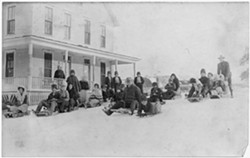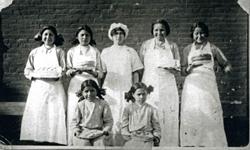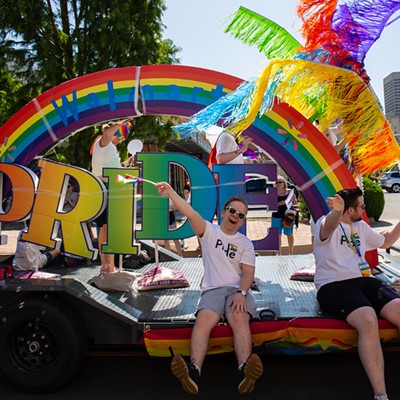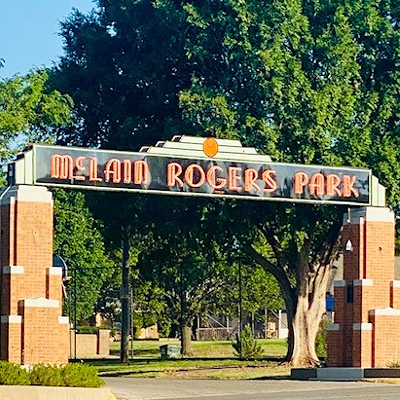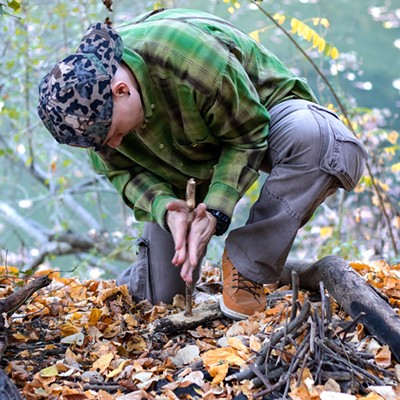In May 2021 Tk’emlúps te Secwépemc First Nations announced they had used ground penetrating radar to confirm unmarked graves of 215 children, later revised to 200, at the former Kamloops Indian Residential School in British Columbia.
This confirmation came on the heels of the report by the Canadian Truth and Reconciliation Commission. This report, released in 2015, recommended a list of 94 calls to action to address the history and continuing impacts of Canada's residential school system on survivors and their descendants. There were a reported 4,100 deaths at the residential schools since their inception in 1894. The Commission estimated that there would be an additional 3,200 confirmed in unmarked graves. To date only five of those schools, a mere 2.5 percent, have been searched, with a total of 1,397 unmarked graves found.
Numbers from the Chemawa Indian School in Salem, Ore. pale by comparison. In 2016, Marsha Small, a doctoral candidate working on her thesis, used ground penetrating radar at Chemawa and confirmed 222 sets of remains, higher than the reported total of 208 buried there. These 14 souls didn't rate much of a mention — much less a headline — in 2016, so why bring them up now?
Because Chemawa is in our country, and it's a name that should have been on our lips years ago. Instead, it was buried along with those Native children.
While nominally taught in schools, complete Native history is actually fraught with many tiny genocides: smallpox blankets, massacres, The Trail of Tears. They all reverberate today but the most insidious are the Indian Boarding Schools. These macabre discoveries continue to this day, with an ongoing body count of helpless children who were slaughtered or neglected until their deaths.
On Nov. 15, confirmation came that 100 Indigenous youths at Genoa Indian School in Nebraska died of gunshot wounds, drowning and disease.
This has been but one atrocity. There are thousands that are still scared to talk or be heard. The memory of that time colors the days of those that made it through. They have lived with the terror of knowing their friends disappeared. For some, that terror was compounded because they saw it happen. They remember not only those that were lost but know what their own lives could have been had they not also been stolen. They know where the bodies are buried and soon you will too. Then you will finally understand that though there are survivors of these "schools," none of our Native children ever really made it home.
A dark history
Gen. Richard Henry Pratt was the architect of the Indian Boarding School system in America. In the 1870s, Pratt had presided over 72 Comanche, Caddo, Kiowa, and Cheyenne POWs at Ft. Marion, prisoners held to ensure their families in the west would comply with the orders of the federal government. During his time as captor he implemented educational courses to assimilate the POWs into American society. This required them to dress in uniforms and cut their hair.
To be clear, this was not some gentle act. His attitude towards the Natives held captive under his authority is best illustrated by this quote: "A great general has said that the only good Indian is a dead one, and that high sanction of his destruction has been an enormous factor in promoting Indian massacres. In a sense, I agree with the sentiment, but only in this: that all the Indian there is in the race should be dead. Kill the Indian in him, and save the man.”
Satisfied with the outcome with the prisoners, he petitioned the government to support the Carlisle Indian Industrial School. It would remove children from their homes to a school far away and immerse them in American culture in order to civilize them. Carlisle became the template for not only the Canadian residential school system but for the 367 schools that would eventually open in 29 states across the country, 83 of them in Oklahoma.
Starting in 1879, hundreds of thousands of Native American children were forced to go to these Indian boarding schools, run by the federal government and various churches. While some chose to attend, the vast majority did not. These children were either kidnapped or their parents were forced to bring them to these schools by the denial of their rations or imprisonment. They literally starved Natives in order to take their children, many of which were hidden by their families. Tribes moved near the schools, trying to maintain contact but there was no chance of reconnection under Pratt’s system.
The government then consigned the children to boarding schools or gifted them to white families. These "adoptions" aren't some practice from the distant past. As late as 1952, a mission in South Dakota sold a Native child for a $10 donation.
The boarding schools were “schools” in name only. Students were put to work in the laundry or in the fields, backbreaking work under the guise of "vocational training" that also offset the cost of operation.
The children had their hair forcibly cut. If they spoke their language, practiced their customs, or danced, they were beaten. Sometimes their fingers were cut off for speaking their language. Abuse and death were rampant. Most schools had cemeteries. Some had incinerators. While this treatment didn't continue into the 1990s, these “boarding schools” remained open until then, when they were either taken over by the tribes or closed.
There is no exact known number of how many Native children were forced into these schools, but by 1926, nearly 83 percent of Indian school-age children were attending them.
In 1928, the U.S. government commissioned the Meriam Report, which found the schools overcrowded and unsanitary. The students were weak from malnourishment being overworked. It noted that death rates for Native students attending the schools were six and a half times higher than for other ethnic groups.
A survivor speaks
Oklahoma Gazette spoke, on condition of anonymity, with a survivor of Carter Seminary in Ardmore who attended in the 1950s. These are among their horrifying revelations, provided linearly to accentuate their brutality:
— "I was only six years old when I was sent there. I had no relatives, and didn't know anyone. I'd cry myself to sleep at night wanting to be home. There was constant homesickness. We were force fed religion and bussed into the local town for church services. It was an all-white Southern Baptist Church, and we Natives were forced to sit in the balcony. This was during the 1950s.”
— “When I was 12, a 10 year old child hung himself. Later, a young girl slit her wrists. She was only an adolescent.”
— “I saw very young children punished for speaking their Native language. Ironically, our country was using those languages in war efforts as code talking.”
— “There was violence. I recall one Bureau of Indian Affairs employee using his fists in disciplining young children.”
— “It wasn't just me [or other children]. I know an older Creek man, he was forced to sit on a hot radiator for speaking Creek.”
— “There's more, much more. Another thing: we ate fried eggs for breakfast about once per week. If one was 6 years old, one got one egg; if one was 6 feet tall and weighed 200 pounds, one got one egg. The food wasn't good, just government commodities. There were rumors the [Bureau of Indian Affairs] employees were stealing prime cuts of meat.”
— “I remember when I was sent there, all our bed clothing and sundries were government issue. We were also given vaccinations; we were given 5 and 6 immunizations. Afterward, I was standing with a group who had just been vaccinated. A BIA employee asked if we got our shots; I responded in the affirmative. But the other little boys spoke no English. They were forced to go through the line twice. We were all only 6 and 7 years old. I remember they became very sick.
— “I visited an Indian school friend earlier today. He's a year younger than I. He couldn't speak English when he started school. Those bastards beat his language out of him, making him ashamed of himself, affecting his self-esteem, his 'Indianness'. We both hated that place … We both survived. After my visit in my vehicle, I broke down and cried. I'm sure he cried too. We were alone crying. That's how we let our emotions out as children. We cried alone. I could still see the hurt in him, being punished for speaking our beautiful Mvskoke language. We've been crying for decades. This shit doesn't heal. It festers. We couldn't tell anyone. It was a long time ago, but I'll hate that place as long as I live."
Echoes of inhumanity
The U.S. government attempted to understand and address the issues of the boarding schools. In 1969, the Senate convened a Special Subcommittee on Indian Education which issued the report “Indian Education: A National Tragedy, a National Challenge,” also known as the Kennedy Report. It concluded that "coercive assimilation” has had “disastrous effects on the education of Indian children.”
Congress further passed the Indian Self-Determination and Education Assistance Act of 1975. This act gave Tribal Nations more control over the schools as well as allowing them to establish their own schools on reservation land.
In 1978, Congress passed the Indian Child Welfare Act, giving Native American parents the legal right to refuse their child's placement in schools. That was also the year The American Indian Religious Freedom Act of 1978 was passed, once again making it legal for Natives to practice their cultures, which had been outlawed by the Code of Indian Offences in 1883.
As of 2020, the Bureau of Indian Education operates approximately 183 schools, mostly non-boarding, and primarily located on reservations, with a student population of about 46,000. On June 22, 2021 Secretary of the Interior Deb Haaland announced the Federal Indian Boarding School Initiative in an address to the National Congress of American Indians (NCAI) during a virtual conference. In a press release, the Department of Interior stated "...the Department shall undertake an investigation of the loss of human life and the lasting consequences of residential Indian boarding schools. The primary goal of the investigation shall be to identify boarding school facilities and sites; the location of known and possible student burial sites located at or near school facilities; and the identities and Tribal affiliations of children interred at such locations."
Sept. 30, 2021 is recognized by First Nations and Natives as Orange Shirt Day, held then as it was the time of year when Indigenous children were taken from their homes to the schools. The day recognizes residential and boarding school survivors and those that never came home. Orange is worn to commemorate the color of the shirt that Phyllis Jack Webstad was wearing on her first day at residential school. Her clothes were taken, including the new orange shirt her grandmother bought her that she would never see again. She was six years old.
Also on Sept. 30, the co-chairs of the Congressional Native American Caucus, U.S. Reps Sharice Davids (Ho-Chunk) and Tom Cole (Chickasaw), with Sen. Elizabeth Warren introduced a bill for a Truth and Healing Commission on Indian Boarding School Policies in the U.S. The proposed commission will examine the ongoing impact of Indian Boarding Schools, locate government and church records, hear testimony of survivors, and will work to locate the children previous administrations have worked so hard to hide.
These schools did not exist in a vacuum. They have impacts still being felt today. Many of those institutionalized at a young age never learned how to parent, feel safe, or thrive. This intergenerational and historical trauma translates into cycles of violence and abuse, alcohol and drug abuse, low high school graduation rates, poverty, homelessness, and high suicide rates. For most young Natives, they are the first generation not to be forced into these schools since their inception in 1870. That means their parents, aunts and uncles and grandparents all survived this horrific abuse. With that abuse comes the loss of cultures, of language, of community. The schools as they were may no one longer exist but are still stealing Native children.
Time will tell if these overtures by the government will be a true reckoning of what has happened and how it continues to affect Native families. Only those affected can decide if now is the time to heal.
If you need help:
The National Native American Boarding School Healing Coalition: https://boardingschoolhealing.org 24-hour Indian Boarding School crisis line: 866-925-4419

